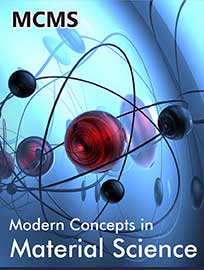 Research Article
Research Article
Study on Thermal Activation Barrier for Dislocation Motion by Strain-Rate Cycling Tests Combined with Ultrasonic Oscillations
Yohichi Kohzuki*
Department of Mechanical Engineering, Saitama Institute of Technology, Japan
Yohichi Kohzuki, Department of Mechanical Engineering, Saitama Institute of Technology, 1690 Fusaiji, Fukaya, Saitama 369-0293, Japan.
Received Date:October 12, 2022; Published Date:October 20, 2022
Abstract
The strain-rate cycling tests between two strain-rates of 1.1×10−5 s−1 and 5.5×10−5 s−1 in the middle of ultrasonic oscillatory stress were conducted during the plastic deformation of NaBr:Li+ (0.5 mol%) single crystals at 77 to 263 K. This method is considered to give the effective stress p, when a dislocation begins to overcome the isotropic defects produced around the additive ions (Li+) in the ionic crystal with the help of thermal activation. Then, the τp-temperature relationship is fitted to the Cottrel-Bilby model within the temperature by numerical calculation with the parameters: τp value (1.08 MPa) at 0 K, Tc(469 K) and G0(0.50 eV) for the ionic crystal. Tc is the critical temperature at which τp is zero. G0 is the activation energy for the dislocation motion.
Keywords:Dislocation; Isotropic defects; Plastic deformation; Ultrasonic oscillation; Strain rates
Introduction
It is well known that a dislocation will encounter a stress field illustrated schematically in Figure 1 as it moves through on the slip plane containing many weak obstacles and a few strong ones [1,2]. In the figure, the positive stress concerning axis of the ordinate opposes the flow stress (applied stress), τ, and the negative stress assists it. Extrinsic resistance to the dislocation motion has two types: one is long-range obstacle (the order of 10 atomic diameters or greater) and the other short-range obstacle (less than about 10 atomic diameters). The former is considered to be forest dislocations, large precipitates or second-phase particles, and grain boundary, for instance, and the latter impurity atoms, isolated and clustered point defects, small precipitates, intersecting dislocations, etc. Overcoming the latter type of obstacles (byname, thermal obstacles) by a dislocation, thermal fluctuations play an important role in aid of the flow stress above the temperature of 0 K. As both resistances simultaneously act on a dislocation, the flow stress τ consists of two components: an internal stress τi (athermal component) due to the long-range obstacles and an effective stress τ* due to short-range ones (thermal component). τ is given by the following Equation 1, since τ* depends on temperature T and strain rate ε̇ [3, 4].


Then the aid energy, G*, supplied by the thermal fluctuations is given by the shaded part in Figure 1. Thus, the dislocation can move through below τ0. τ0 is the value of τ at 0 K. As for the long-range obstacles (byname, athermal obstacles), the energy barrier is so large that the thermal fluctuations play no role in overcoming them within the temperature.
The representation of Figure 2 is concerned with a common type of thermal activation barrier. The free energy (G) varies with the distance(x)between a dislocation and the obstacle as given in Figure 2(a). When a dislocation overcomes the short-range obstacles, the free energy becomes high on account of the work (W) done by the applied stress. Then the resistance (F), where it can be defined by the differentiation of free energy with respect to x (i.e., ∂G* /∂x ), to the dislocation motion is revealed as Figure 2(b) in accord with the abscissa of Figure 2(a). Figure 2(b) corresponds to the typical force-distance curve for the short-range obstacle among those in Figure 1. Shape of this curve represented by F(x)means the model overcoming the obstacle by a dislocation. G0, which is taken as the shaded area under F(x) in Figure 2(b), is the Gibbs free energy of activation for the breakaway of a dislocation from the obstacle in the absence of an applied stress (in this case it is equivalent to the Helmholtz free energy for the dislocation motion). G* in Figure 1 corresponds to the difference between G0 and



where b is the magnitude of the Burgers vector, L is the average length of dislocation segments, x0 and x2 are the values of x at which F equals the defect force, and F0 is the maximum value of F (i.e., F at the distance x1 ).
Results and Discussion
The strain-rate cycling tests associated with ultrasonic oscillation (20 kHz) were carried out during plastic deformation for NaBr single crystals doped with Li+ ions. The concentration of the dopant ions was 0.5 mol% in melt. Figure 3 shows the experimental results on Δτ vs. λ for the crystals at various temperatures and a given strain. The numbers besides each symbol in the figure represent the temperature of the crystal. Δτ is the stress drop due to superposition of ultrasonic oscillatory stress. λ (λ=Δτ’/Δlnε̇) is the strainrate sensitivity of flow stress and was obtained from the stress change (Δτ’) due to the strain-rate cycling between the two strain rates (1.1×10-5 and 5.5×10-5 s-1) in the middle of ultrasonic oscillatory stress [5,6]. The relative curves have stair like shape below 263 K in Figure 3 [7]. The Δτ value at first bending point is termed τp, as denoted in Figure 3. The value of τp becomes smaller at higher temperature and disappears at 263 K. Because it has been reported for other crystals that its value depends on temperature and impurity concentration [8,9], the τp is considered to represent the effective stress due to the dopant ions which lie on the dislocation when a dislocation begins to overcome the defects produced around the dopants with the help of thermal activation during plastic deformation. The plots in Figure 4 represent τp for NaBr:Li+ single crystals at 77 to 263 K.


Isotropic defects occur around them in NaBr single crystals doped with monovalent ions, since their size is different from the substitutional ions (Na+) of the host crystal. The force-distance profile between a dislocation and the symmetry defect is expressed by the Cottrell and Bilby relation [10] taking account of the Friedel relation [11]. As a function of the distance x along the slip plane away from the obstacle by ρ, the force F interacting between a dislocation and an obstacle is given by [10]

where F is maximum at . The relation between the effective stress and temperature for NaBr:Li+ (0.5 mol%) crystal is exhibited as the solid curve in Figure 4, where is determined by numerical calculation with the parameters: τp0, Tc, and G0(0.50eV). τp0(1.08 MPa) is the value of τp at the temperature of 0 K. Tc (469 K) is the critical temperature at which τp is zero. Figure 4 shows that the curve agree with the τp data (i.e., solid circles in the figure), which is based on Δτ vs. λ at a given strain (see Figure 3), within the temperature.
Conclusion
Overcoming the isotropic defects around the dopants (Li+) in NaBr:Li+ crystal by a dislocation with the help of thermal activation during plastic deformation, the effective stress τp becomes smaller and smaller with the temperature below 263 K. The temperature dependence of τp is approximated to the Cottrell-Bilby relation. Then, the parameters are estimated to be τp0(1.08 MPa), Tc (469 K) and G0(0.50 eV) for the ionic crystal.
Acknowledgment
None.
Conflict of Interest
No conflict of interest.
References
- Conrad H (1964) Thermally activated deformation of metals. Journal of Metals 16: 582-588.
- Messerschmidt U (2010) Dislocation Dynamics During Plastic Deformation. Berlin Heidelberg: Springer, pp.180-187.
- Sprackling MT (1976) The Plastic Deformation of Simple Ionic Crystals. Academic Press, London, pp.128-129.
- Argon AS (2008) Strengthening Mechanisms in Crystal Plasticity. Oxford University Press Inc., New York, pp.106-108.
- Kohzuki Y, Ohgaku T (2016) I- ions as obstacles to dislocation motion in NaCl:I- single crystals. Journal of Materials Science and Chemical Engineering 4: 1-8.
- Kohzuki Y (2018) Study on dislocation-dopant ions interaction in ionic crystals by the strain-rate cycling test during the Blaha effect. Crystals 8(1): 31-54.
- Kohzuki Y, Ohgaku T (2017) Study on influence of additive and host ions on deformation characteristics of alkali halide crystals by strain-rate cycling tests during the Blaha effect. Crystal Research and Technology 52(3): 1600290.
- Ohgaku T, Teraji H (2001) Investigation of interaction between a dislocation and a Br− ion in NaCl:Br− single crystals. Physica Status Solidi (a) 187(2): 407-413.
- Ohgaku T, Matsunaga T (2009) Interaction between dislocation and divalent impurity in KBr single crystals. IOP Conference Series: Materials Science and Engineering 3: 012021.
- Cottrell AH, Bilby BA (1949) Dislocation theory of yielding and strain ageing of iron. Proceedings of the Physical Society of London A 62: 49-62.
- Friedel J (1964) Dislocations. Pergamon Press, Oxford, pp. 223-226.
-
Yohichi Kohzuki*. Study on Thermal Activation Barrier for Dislocation Motion by Strain-Rate Cycling Tests Combined with Ultrasonic Oscillations. Mod Concept Material Sci. 5(1): 2022. MCMS. MS.ID.000601.
-
Dislocation, Isotropic defects, Plastic deformation, Ultrasonic oscillation, Strain rates, Effective stress, Temperature, Crystal, Thermal fluctuations, Obstacles, Parameters
-

This work is licensed under a Creative Commons Attribution-NonCommercial 4.0 International License.






